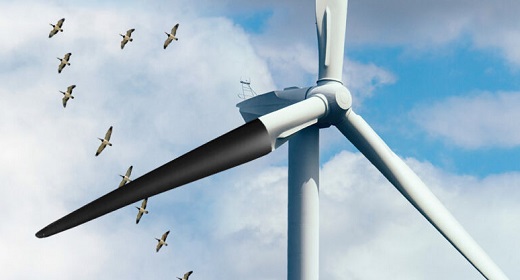by Jonathan Gitlin: The study ran for nine years at Norway’s Smøla wind farm…
Something as simple as black paint could be the key to reducing the number of birds that are killed each year by wind turbines. According to a study conducted at a wind farm on the Norwegian archipelago of Smøla, changing the color of a single blade on a turbine from white to black resulted in a 70-percent drop in the number of bird deaths.
Wind power is surging right now, with more than 60GW of new generating capacity added worldwide in 2019. As long as you put the turbines in the right spot, wind power is reliably cheaper than burning fossil fuels. And most people would prefer to live next to a wind farm than any other kind of power plant—even solar.
Not everyone is a fan of wind turbines, however, because of their impact on local populations of flying fauna like birds and bats. Politicians with axes to grind against renewable energy say that we should continue to mine coal and extract oil because of the avian death toll, and US President Donald Trump has called wind turbines “bird graveyard[s].” Estimates from the US Fish and Wildlife Service calculated that approximately 300,000 birds were killed by wind turbines in 2015 (which is probably two orders of magnitude fewer than die as a result of colliding with electrical power lines each year), and bird deaths from turbines are trending down as the industry moves to larger turbine blades that move more slowly.
Bird deaths caused by wind power may be overstated then, but they do still occur. Previous laboratory studies have suggested that birds may not be very good at seeing obstructions while they’re flying, and adding visual cues like different colored fan blades can increase birds’ chances of spotting a rapidly rotating fan.
At the Smøla wind farm, regular checks of four particular wind turbines—each 70m tall with three 40m-long blades—found six white-tailed eagle carcasses between 2006 and 2013. In total, the four turbines killed 18 birds that flew into the blades over those six years, along with five willow ptarmigans that are known to collide with the turbine towers rather than the blades. (Another four turbines selected as a control group were responsible for seven bird deaths, excluding willow ptarmigans, over the same timeframe.)
And so, in 2013, each of the four turbines in the test group had a single blade painted black. In the three years that followed, only six birds were found dead due to striking their turbine blades. By comparison, 18 bird deaths were recorded by the four control wind turbines—a 71.9-percent reduction in the annual fatality rate.
Digging into the data a little more showed some variation on bird deaths depending upon the season. During spring and autumn, fewer bird deaths were recorded at the painted turbines. But in summer, bird deaths actually increased at the painted turbines, and the authors note that the small number of turbines in the study and its relatively short duration both merit longer-term replication studies, both at Smøla and elsewhere.








































